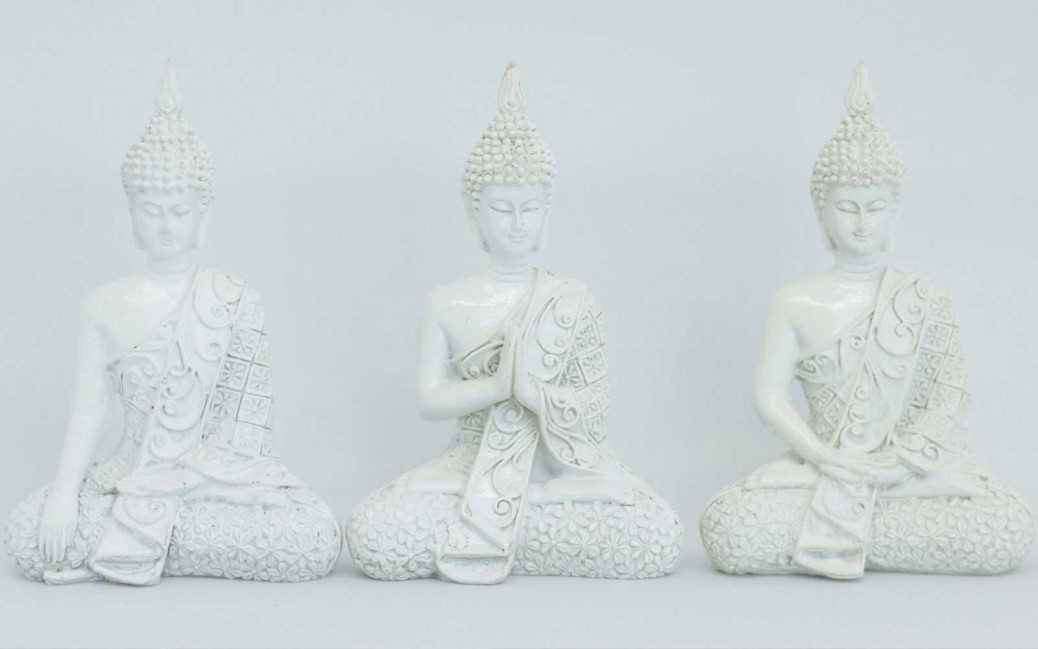THROUGH SAMYAMA THE IMAGE OCCUPYING ANOTHER’S MIND CAN BE KNOWN.
If you attain one-pointedness, if you attain to samadhi. and if you become so deeply silent that not a single thought moves in your mind: you become capable of seeing the images in other people’s minds. You can read their thoughts.
I have heard a joke that two yogis met. Both have attained to samadhi. There was nothing to talk about, but one has to say something when you meet. One yogi said, “I would like to share a joke with you. It is very old. Once – “ And the other started laughing.
That’s the whole joke. He could see the whole joke unuttered.
If you are silent, through your silence you become capable of seeing into another’s mind. Not that you have to, not that you should do it. Patanjali is saying everything that comes on the way. In fact a real yogi never does it because that is trespassing the freedom of the other, that is violating the privacy of the other; but it happens.
And Patanjali in this chapter “Vibhuti Pada” is talking about all these miracles not that one should strive to attain them, but just to make you aware and alert that they happen and don’t get caught by them, and don’t use them – because once you start using them, your growth stops. The energy then is stuck there.
Don’t use them. These sutras are to make you alert and aware that these things will happen, and there is a tendency in the mind, a temptation to use them. Who would not like to see into another’s mind? You have tremendous power then over the other, but yoga is not a power trip, and a real yogi will never do it.
But it happens. There are people who try to attain it, and it can be attained. It can be attained even without being religious. Even without being a real disciple of yoga, it can be attained.
Sometimes it happens just by accident also. If your mind comes to a silent stage in any way, you are capable of looking into the images of the other’s mind, because when your mind is silent the other’s mind is not very far away. It is very close. When your mind is crowded with thoughts then the other’s mind is very far away because the crowd of your own thoughts distracts you. The noise of your own inner traffic is so much, you cannot hear the other’s thoughts.
Have you watched it? Sometimes ordinary people, not concerned with meditation, not concerned with yoga or any telepathic powers or any supraphysical sensibilities, they also sometimes become aware of certain things happening to them. For example, if a couple loves each other deeply, by and by they become so attuned to each other they start becoming aware of the other’s thoughts. The wife becomes aware of what is moving in the mind of the husband. She may not be aware of this awareness, but in a subtle way she starts feeling what is happening to the mind of the husband. She may not be clear, it may be a confused picture, may not be in focus, may be a little blurred, but lovers by and by become aware of a certain capacity to feel the other. The mother, if she loves the child, becomes aware of the needs of the child – unuttered.
There is a path somewhere by which you are connected with the other. We are connected with the whole.
Patanjali says, “Through SAMYAMA,” attaining to one-pointedness, to the inner balance, to samadhi, to silence and tranquillity, “the image occupying another’s mind can be known.” You have just to focus yourself towards the other. Just in deep silence you have to remember the other. Just in deep silence you have to look at the other, and immediately you will see his mind opening before you like a book.
But no need to do it. Because once this becomes possible, many more possibilities surround it. You can interfere, you can direct the other’s thoughts. You can enter into the other’s thoughts and put your thoughts there. You can manipulate the other and he will never become aware that he has been manipulated and he will think he is doing his own thoughts and he is following his own ideas. But these things are not to be done.
BUT PERCEPTION THROUGH SAMYAMA DOES NOT BRING KNOWLEDGE OF THE MENTAL FACTORS THAT SUPPORT THE IMAGE IN ANOTHER’S MIND, FOR THAT IS NOT THE OBJECT OF SAMYAMA.
You can see the image – that doesn’t mean that you will see the motive also. For motive you will have to go still deeper. For example, you see somebody and you can see the image inside the mind; for instance, there is an image of the moon, a beautiful full moon surrounded by white clouds. You can see the image, this is okay, but you don’t know the motivation why the image is there. If he is a painter the motivation will be different. If he is a lover the motivation may be different. If he is a scientist the motivation may be still different.
What his motivation is, why the image is there – just by watching the image you cannot know the motivation. Motivation is more subtle than the image. Image is a gross thing. It is there on the other’s mind’s screen, you can see it, but why is it there? Why in the first place did it happen? Why is the other thinking about the moon? He may be a painter, a poet – a lunatic. Just by looking in the image you don’t become aware of the motivation. For motivation you will have to go still deeper in you.
The motivation is known only when you attain seedless samadhi, not before it, because motivation is so subtle. It has no image, nothing visible; it is the invisible desire into the deep unconscious of the man. When you have become completely aware and your desires have dissolved…. Look. When your thoughts dissolve you become capable of reading others’ thoughts: when your desires dissolve you become capable of reading others’ desires.
BY PERFORMING SAMYAMA ON THE FORM OF THE BODY TO SUSPEND RECEPTIVE POWER.
THE CONTACT BETWEEN THE EYE OF AN OBSERVER AND THE LIGHT FROM THE BODY IS BROKEN, AND THE BODY BECOMES INVISIBLE.
You must have heard stories about yogis who can become invisible. Patanjali tries to reduce everything to a scientific law; he says there is no miracle there also. A person can become invisible by a certain understanding of a certain law.
What is that law?
Now physics says if you are seeing me you are seeing only because sun rays fall on me and then they move, reflect from me. Those sun rays falling on your eyes, that’s why you are seeing me. If there is some way, if I can absorb the sun rays and they don’t reflect, you will not be able to see me. You can see only if sun rays come to me. If there is darkness and there are no sun rays coming, you cannot see me. But if I can absorb all the sun rays and nothing is reflected back, you will not be able to see me. You will see only a dark patch.
That’s what modern physics also says; that’s how we see colors. For example, you are wearing orange; I can see that you are wearing orange. What does it mean? It simply means that your clothes are reflecting the orange ray back. All other rays are being absorbed by your clothes. Only the orange color ray is being reflected.
When you see white it means all rays are reflected back. White is not a color; all colors are reflected back. White is all colors together. If you mix all colors they become white, so white is all colors; it is not a color. And if you are using a black dress then nothing is reflected back; all the rays are being absorbed. That’s why your dress looks black. Black is also not a color; it is no-color, all rays absorbed.
That’s why if you use black in a hot country you will feel tremendously hot.
Don’t use the color black and move into the hot sun. You will feel very hot because the black goes on absorbing everything. White is cooler. Just looking at white, a coolness. Using white you feel cool because nothing is absorbed, everything reflected back.
In India Jainism has chosen white as their color because of renunciation – because it renounces all. The white color renounces all. It gives back everything, absorbs nothing. Death is depicted everywhere as black because it absorbs everything. Nothing comes out of it, everything dissolves into it and disappears.
It is a black hole. The devil is depicted everywhere as black, evil is depicted everywhere as black, because it is not capable of renouncing anything. It is too possessive. It cannot give anything: it cannot share.
Hindus have chosen orange as their color for a certain reason, because red rays are reflected back. The red ray entering the body creates sexuality, violence. Red is the color of violence, of blood. The red ray entering the body creates violence, sexuality, passion, disturbance. Now the scientists say that if you are left in a room colored completely red, within seven days you will go mad. Just nothing else is needed; just seeing red things continuously for seven days. Everything red – curtains, the furniture. Everything red the walls. Within seven days you will go mad; the red will be too much. Hindus have chosen red, and shades of red – orange, ochre, and others – because they help you to become less violent. The red ray is reflected back; it doesn’t enter into the body.
Patanjali says that a man can become invisible if he can absorb all the rays that fall on him. You will not be able to see him. You may be able to see just an emptiness, black emptiness, but the man will become invisible. How does it happen to a yogi? Sometimes it happens. Sometimes it happens and the yogi is unaware of it. Let me explain to you the mechanism of it.
In Patanjali’s system of thought there is a deep correspondence between the outer world and the inner. It has to be; they are together. There is light; from the sun comes the light. Your eyes are receptive to it. If your eyes are not receptive to it the sun may be there, but you will live in darkness. That’s what happens to a blind man – his eyes are not receptive. So your eyes somehow correspond with the sun. In your body your eyes represent the sun; they are joined together. The sun affects the eyes; the eyes are sensitive towards it. Sound affects your ears.
Sound is outside; ears are in you.
The outside reality is known as tattva, the element, and the inside correspondence is known as tanmatra. In Patanjali’s system these two are very essential to be understood. The tattva is the outside reality, the sun, and corresponding to it is something in your eye which he calls tanmatra, the essential element inside you. That’s why there is a dialogue between the eye and the sun, between the sound and the ear, between the nose and the smell. There is a correspondence, invisible; something is joined and bridged.
When one goes on meditating and comes to understand the gaps, nirodh, then accumulates gaps, samadhi, then arises one-pointedness, ekagrata parinama; then one can look into the tanmatras, the inner elements, the subtle elements. You have seen the sun with the eye, but you have not seen your eye up to now. Only in a deep emptiness one becomes alert and can see his own eye. You have heard the sound, but you have not heard your ear responding to it. The vibration that comes to your ear, the subtle vibration, you have not heard that yet. It is too subtle and you are too gross. You are not yet so refined. You cannot hear that subtle music. You have smelled the rose, but you have not yet been able to smell the subtle element in you which smells rose, the tanmatra.
The yogi becomes capable of listening to the inner sound, which is silence; of seeing the eye, the inner eye, which is pure vision. And there is the mechanism of becoming invisible “By performing samyama on the form of the body….”
If the yogi just concentrates on his form of the body, his own form of the body, just by that concentration on the form the sun rays are absorbed in the form and they are not reflected back. When you concentrate on the form, the form opens.
All the closed doors open and the sun rays enter into the form and the tanmatra of your form absorbs the tattva of the sun, and suddenly nobody can see you.
Because to see, the light must be reflected.
Tags: Patanjali Yoga Sutra 35 Vibhuti Pada










